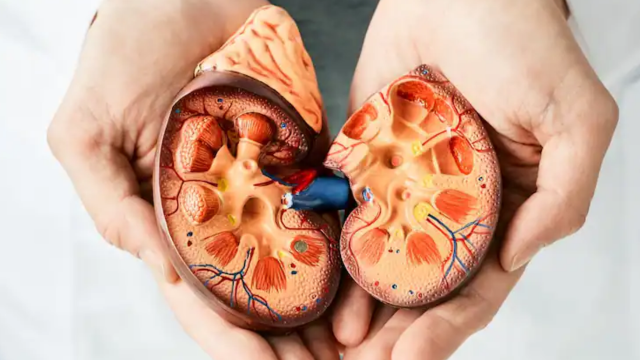November 14, 2025 : India is witnessing an alarming rise in Chronic Kidney Disease (CKD), with recent estimates placing the affected population at 138 million, making it the second highest CKD burden globally. Public health experts warn that the condition—often undiagnosed until advanced stages—is fast becoming one of India’s most severe non-communicable health threats.
A Silent, Growing Epidemic
CKD is characterized by the gradual loss of kidney function over time. In India, the condition often remains undetected until it progresses to advanced stages, primarily because early symptoms are subtle or mistaken for general fatigue, dehydration, or lifestyle stress.
Medical researchers note that the growing prevalence is linked to lifestyle diseases, particularly diabetes, hypertension, and obesity. India already carries the world’s highest diabetes burden and a rapidly expanding hypertensive population, creating a perfect storm for kidney-related complications.
Dr. Kavita Sharma, a senior nephrologist based in Delhi, explains, “CKD in India has transformed into a lifestyle-driven condition. Young adults, working professionals, and even adolescents are increasingly at risk due to poor dietary habits, high salt intake, and sedentary lifestyles.”
Why India Is Seeing a Surge
Several factors contribute to the sharp spike in CKD cases across the country:
- High prevalence of diabetes – Nearly one in 11 Indians is diabetic, making diabetic kidney disease a top contributor.
- Uncontrolled hypertension – Often undiagnosed and unmanaged.
- Rising obesity levels – Increasingly common among young adults.
- Environmental toxins & polluted water sources – Particularly in rural and industrial regions.
- High consumption of over-the-counter painkillers – NSAIDs are linked to kidney damage.
- Delayed medical intervention – Most patients seek help when kidneys lose 60–70% of their function.
In rural India, lack of awareness and limited access to specialized healthcare facilities worsen the situation. Urban India faces the opposite problem—overburdened hospital systems where early-stage kidney disease screenings are still not routine.
Economic and Social Impact
The economic burden of CKD is massive. Dialysis—required for end-stage renal disease (ESRD)—costs anywhere between ₹2–4 lakh per year per patient, making it unaffordable for a majority of Indians. Kidney transplant costs are even higher, and post-transplant medication expenses create lifelong financial pressure.
For low-income families, CKD often forces catastrophic health expenditure, pushing households into long-term debt or poverty.
A study published in a national health journal estimates that only 10% of Indian patients who need dialysis actually receive it, primarily due to costs or lack of availability.
State-Wise CKD Hotspots
Although CKD affects the entire country, some states show disproportionately higher numbers:
- Uttar Pradesh
- Bihar
- West Bengal
- Maharashtra
- Andhra Pradesh
- Punjab (due to the “cancer belt” and water contamination issues)
Rural belts in Andhra Pradesh and Odisha have also reported unusually high CKD rates unrelated to diabetes or hypertension, indicating the potential role of environmental and occupational hazards.
Government Response and Challenges
The Indian government has taken several steps to address the CKD crisis:
- National Dialysis Programme (NDP) provides free dialysis in district hospitals.
- Ayushman Bharat covers dialysis and transplant costs for eligible beneficiaries.
- Health and Wellness Centres offer screenings for hypertension and diabetes.
However, experts argue that India lacks a comprehensive kidney-screening initiative, and early detection remains minimal. Many primary-care physicians also lack adequate training to diagnose CKD in early stages.
“Screening high-risk populations—diabetics, hypertensives, and the elderly—could save millions of lives and reduce healthcare burdens,” says Dr. Rajesh Pai, a Bengaluru-based nephrologist.
The Way Forward
Health analysts emphasize the urgent need for:
- Routine CKD screening, especially for individuals above age 30.
- Public awareness campaigns highlighting risk factors and early symptoms.
- Increase in nephrology specialists and dialysis centers, especially in tier-2 and tier-3 cities.
- Promotion of healthier lifestyle habits to reduce diabetes and hypertension incidence.
- Better regulation of over-the-counter painkiller sales.
- Investment in clean drinking water and environmental safety to reduce toxin-related kidney diseases.
In addition, digital health tools, mobile clinics, and AI-driven screening programs could revolutionize early detection in India’s remote regions.
A Health Crisis India Cannot Ignore
With 138 million individuals affected, CKD is no longer a medical issue but a national public health emergency. Without immediate intervention, India risks facing an unprecedented increase in kidney-failure cases over the next decade. The challenge now lies in building a robust kidney-care ecosystem that prioritizes prevention, early detection, and accessible treatment for all.
Summary
India’s Chronic Kidney Disease cases have surged to 138 million, the second highest worldwide. Rising diabetes, hypertension, lifestyle habits, poor awareness, and limited screening are driving a nationwide kidney health crisis.


